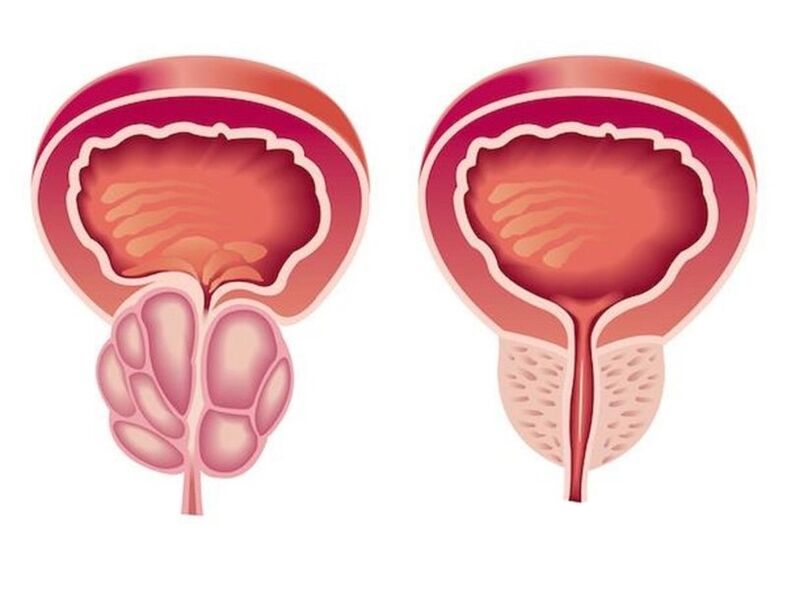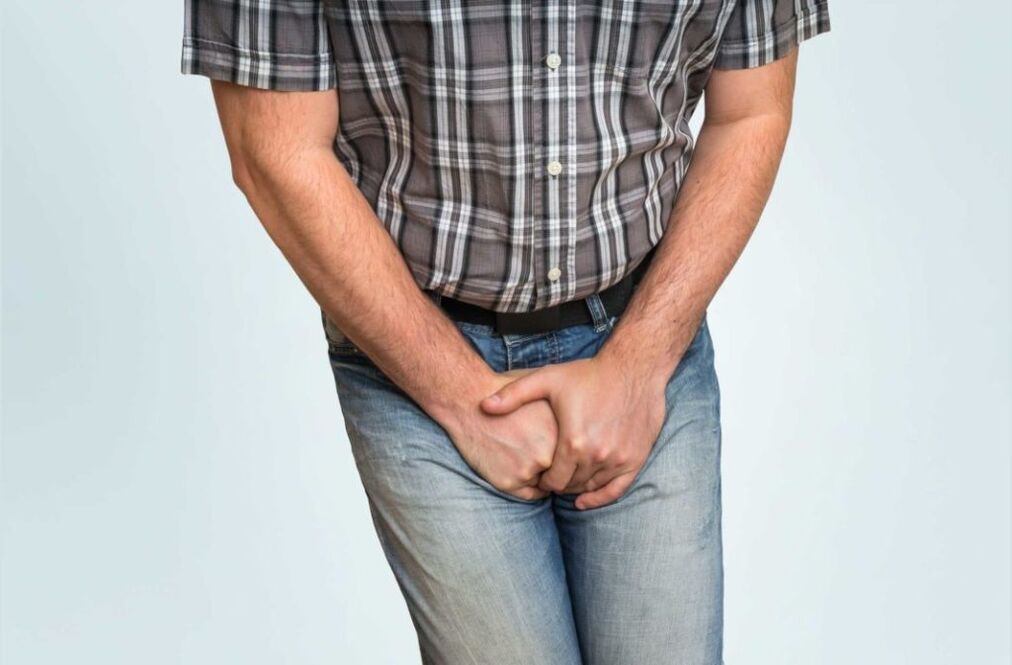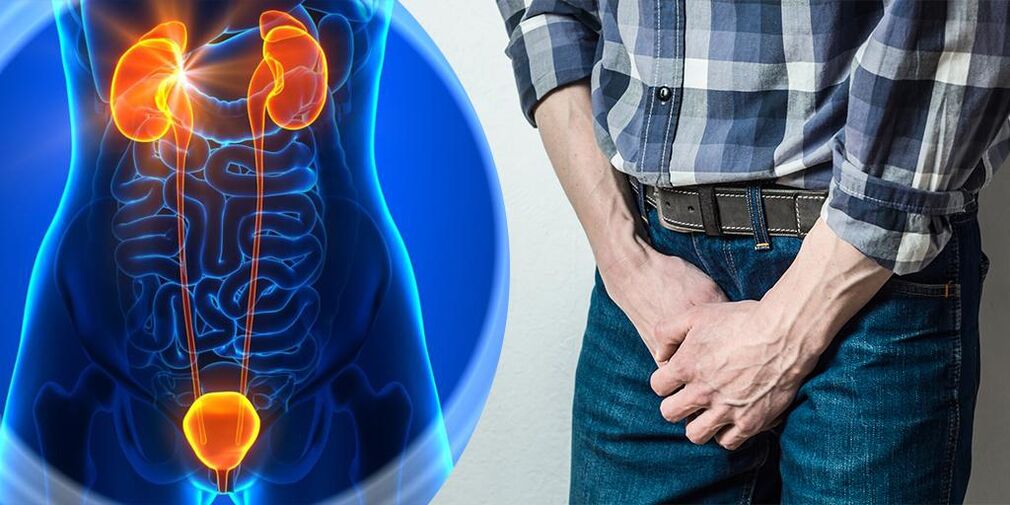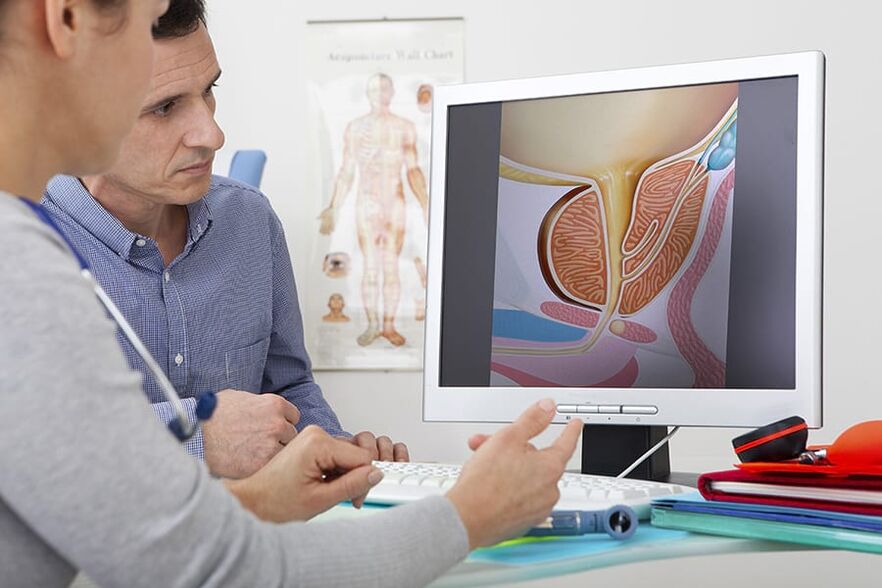Prostatitis is an inflammatory disease of the prostate gland. Frequent campaigns in the restroom, the pain, scrotum, rectum, rectum (erection, early ejaculation, etc. ), sometimes deferred urine and urine are self-insurance. The diagnosis of prostatitis is a urologist or a typical clinical picture, a urologist or other specialist with the results of a rectal study. In addition, the province of prostate, prostatic excretion and urine bacteria are planted. Conservative treatment - antibacterial therapy, immunotherapy, prostate massage, lifestyle.

Prostatitis - Inflammation of the seed (prostate) gland - prostate. It is the most common disease of the genitourinia system in men. Most of the time affects 25-50 years of patients. According to various data, the prostatitis suffers from 30-85% of men over 30 years. Perhaps the inflammation of the prostate gland and additions threatening the infinity, perhaps the violation. The rise of the infection causes inflammation of the upper parts of the genionary system (cystitis, pyelonefrit).
When an infectious agent is included, a pathological agent develops when a genious system (Uretra, bladder) or remote inflammatory focus (pneumonia, tonsillitis) is included in a patroble agent.
Gold Staffilokokscus Aureus (Enterococcus), Enterobacter (enterobacter), Pseudomonas (Pseudomonas), ProteUllah and Klebcellah, Klebcellah, Klebcellah, Klebcellah, Klebcellah, Klebcellah, Klebcellah, Klebcellah, Klebcellah, Klebcellah, Klebcellah, Klebcellah, Klebcellah, can act as an infectious intermediary in a sharp period of time. (Klebsiella) and E. Coli (E. coli). Most microorganisms belong to a conventional pathogenic flora and cause the prostate when there are only other prone factors. Chronic inflammation generally stems from Paul, with microbial unions.
The risk of development of the disease increases during hypothermia, the presence of concrete infections and conditions in the history of clogging in the tissues of prostate. The following inclined factors are different:
- General hypothermia (one or permanent, related to working conditions).
- A seated lifestyle, a specialty forcing a person to be in situations for a long time (computer operator, drive, etc. ).
- Constant constipation.
- Violation of the normal rhythm of sexual activity (excessive sexual activity, long-term extension, incomplete discharge deprived of the emotional painting of "ordinary" sex).
- Having chronic diseases (cholecystitis, bronchitis) or chronic infectious focus on the body (chronic osteomyelitis, absurd current, tonsillit, etc. ).
- Urological diseases (urethritis, cystitis, etc. ) and sexually transmitted diseases (Trichomoniasis, Gonorrhea).
- Inhibition of the immune system (chronic stresses, irregular and low nutrition, regular sleep, athletes in extreme severity).
The risk of pathological development increases with chronic drunkennesses (alcohol, nicotine, morphine). Some studies in the modern andrologic area proves that the factor, motorists, motorcyclists and cyclists prove to be a chronic leap injury (vibration, shaking). However, the number of experts is not the true reasons for all of the cases listed, but contributes to the exacerbation of the secret inflammatory process in the tissues of the prostate.
The decisive role in the formation of the prostatitis, plays stagnation in prostate tissues. Capillary blood flow causes conditions for the development of lipid peroxidation, edema, prostate tissues and the development of the infectious process.

There are three stages of acute prostatitis characterized by a certain clinical picture and morphological changes:
- The sharp cataral. Patients complain quickly, often painful urine, pain and pain in Painum.
- Acutely follicular. The pain becomes more intense, sometimes the anus is lighting, strengthens during defecation. The urine is a hard, a thin flow flows to the urine. In some cases, urinary delay is recorded. Subfebrilite or moderate hyperthermia is typical.
- Acute parenchyme. Common intoxication, hypertermium 38-40 ° C, vibrating, vibrating. Dizuric disorders, a sharp delay in urine often. Acute, pulsating pain in perineum. Difficulty in defecating.
Rarely, chronic prostatitis is becoming a result of a sharp process, but as a rule, an initial chronic course is observed. Temperature sometimes rises to smaller values. During the patient, urine and defecting act, in Perineum, notes weak pain. The most characteristic symptom is a discharge of scarce from the urethra during the defecation act. The main chronic form of the disease is developing over a significant period of time. He is gradually becoming an abacultial prostate in blood stagnation in the capillaries.
The chronic prostatitis is often a complication of an inflammatory process caused by a particular infection (Klamidiya, UREAPLASTA, Gonococcus). In many cases, symptoms of a certain inflammatory process masks the manifestations of the prostate lesion. During the urine, pain, a slight increase in perineum is possible during the shortage of the urethra. A little change in the clinical picture is often out of date by the patient.
The prostate gland can indicate itself with a burning sensation of chronic inflammation, urethra and perineum, dysuria, sexual disorders, growing common fatigue. The outcome of potential violations (or to be afraid of these violations) is often mentally depression, anxiety and irritated. The clinical photo does not always enter all of the listed symptom groups, and in different patients and changes in time. There are three main syndrome features of a chronic prostatitis: the pain, when going to the toilet, the violations, sexual disorders.
There are no pain receptors in the prostate piece. The cause of pain in chronic prostatitis is almost inevitable due to many innervations of pelvic organs in the inflammatory process of nervous roads. Patients complain about the pain of various intensity - to disrupt sleep, disrupting sleep. There is a change in the nature of a blindfold, excessive sexual activity or sexual finish, pain (strengthening or weakening). The pain enters the scrotum, sacrum, crotch, occasionally.

As a result of an inflammation in a chronic prostatitis, the volume of urbeing prostate is growing. The lumen of the ureter is declining. The patient is often urine, the bladder has a sense of incomplete emptiness. As a rule, Dysuric events are expressed in early stages. Then develop compensation hypertrophy of muscle layers of bladder and urethers. During this period, Dysuria's symptoms are weakening and then increased again during the division of adaptive mechanisms.
In the initial stages, the potential violations can be contradicted differently in different patients. Patients can often complain about nightly erection, orgasm or deterioration of a structure. The accelerated ejaculation is associated with a reduction in the center of the center, which is responsible for obtaining an orgasm. Pain can refuse sexual activity for a blindfold. In the future, sexual disorders are even more pronounced. In an advanced stage, the impotence is developing.
The degree of sexual disorder is determined by many factors, including sexual constitution and a psychological mood of the patient. Potential and Disyry Violations, both changes in the prostate gland and how easily the patient can be inspired by something. If you have chronic prostatitis, sexual disorders and urinary disorders are waiting for the development of the inevitable. Especially often in potential, psychogenic disorders and problems to go to the toilet are developing in exciting patients.
In the absence of a timely treatment of acute prostatitis, there is a risk of developing the abscess of the prostate gland. When the elderly focus arises, the patient's body temperature rises to 39-40 ° C and can get a hectic character. Hot periods are alternating with the pronounced cold. The sharp pain in Perineum complicates the urine and defecation is impossible.
Edem edema's growth causes a sharp urine delay. Seldom opens abscess self-urethra or rectum. When opened to Urethra, the purulent muddy urine seems to be an unpleasant sharp smell, when opened in the rectum, there is najis and Mukus.
For chronic prostatitis, a course of a wave with extended remissions is characteristic of a wave, in this process, inflammation in the prostate is hidden or very small in symptoms. Patients that nothing worries, and the patients that have not stopped the treatment and only the development of complications.
The most common complication of the chronic process is inflammation of the inflammation of testicles and testicles and inflammation of seed bubbles. The result of these diseases is often becoming infinity.

A characteristic clinical picture facilitates the process of diagnosis in a sharp and chronic prostatitis. Mandatory is made:
- Rectal study of the prostate
- To determine the sensitivity of the microflora of the fence of the expression of the prostate gland (planting the secret of the prostate and planting the Sider Sider Sider).
- The prostate is distinguished from an ultraction and other diseases of the prostate to determine the structural changes (tumors, cysts, adenoma)
- A spermogram to exclude or approve infertility development.
Patients with a severe process with a sharp process conducting a course of treatment with an urologist. With fierce intoxication, the suspicion of a process of passing, the hospital is displayed. Antibacterial therapy is carried out. Drugs are selected taking into account the sensitivity of an infectious agent. Antibiotics are widely used in prostate texture (ciprofloxacin, etc. ) can penetrate the servant.
With the development of a sharp urinary delay, in the background of the prostatitis, they apply to the installation of a special pipe, because it is not a urethral catheter, because the prostate is in danger of occurring. An endoscopic transmission or urethrautible opening of the abscess with the development of ABSCESS.
The treatment of chronic prostatitis should be complex, including treatment, etiotop therapy, physiotherapy, immunity:
- Antibiotic therapy. Patient is assigned long-term antibacterial courses (within 4-8 weeks). Choosing the type and dose of antibacterial medicines, as well as determining the duration of the treatment course is carried out separately. The medication is selected based on the sensitivity of microflora based on the results of the urinary urine.
- Prostate massage. The cloth massage has a thorough impact on the affected organ. During the massage, the inflammatory cannabis collected in the prostate gland, then entered the urethra and is removed from the body. The procedure improves blood circulation that allows you to minimize stagnation and access the best reputation of antibacterial medications into the texture of the body affected.
- Physiotherapy. Laser exposure to improve blood circulation, ultrasonic waves and electromagnetic vibrations are used. If physiotherapy procedures are not possible, the patient is determined by hot medications microclosolms.
Chronic, long-term inflammation The consultation of the immunologist will show an immunologist's consultation for the choice of the tactics of immunoconomic therapy. The patient is given recommendations for change in lifestyle. The introduction of certain changes in a lifestyle of a patient with a chronic prostatite is both therapeutic and preventive measures. Patient is recommended to normalize sleep and awakening, create a diet and show the average physical activity.

A sharp prostatitis is a disease with a chronic trend. Even with enough treatment in time, more than half of the patients, the chronic prostatitis goes out. The restoration is always possible, but it is possible to eliminate properly consistent therapy and doctor's recommendations, eliminate unpleasant symptoms and achieve a long-term remission in a chronic process.
Prevention is to eliminate risk factors. You need to protect with hypothermia, alternative sedentary work and physical activity periods and make a regular and complete meal. Constipation, laxatives should be used. One of the preventive measures is the normalization of sex life, as it is risk factors in both excessive sexual activity and sexual finish and prostatitis. If the symptoms of an urological or sexually transmitted disease seem to be consulted in a timely manner.
























